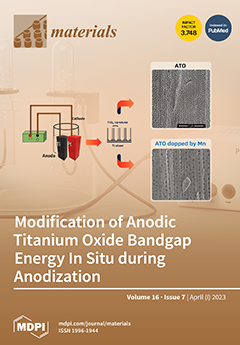The idea of this work is to reduce the negative effect of ordinary Portland cement (OPC) manufacture on the environment by decreasing clinker production temperature and developing an alternative rankinite binder that hardens in the CO
2 atmosphere. The common OPC raw materials,
[...] Read more.
The idea of this work is to reduce the negative effect of ordinary Portland cement (OPC) manufacture on the environment by decreasing clinker production temperature and developing an alternative rankinite binder that hardens in the CO
2 atmosphere. The common OPC raw materials, limestone and mica clay, if they contain a higher MgO content, have been found to be unsuitable for the synthesis of CO
2-curing low-lime binders. X-ray diffraction analysis (ex-situ and in-situ in the temperature range of 25–1150 °C) showed that akermanite Ca
2Mg(Si
2O
7) begins to form at a temperature of 900 °C. According to Rietveld refinement, the interlayer distances of the resulting curve are more accurately described by the compound, which contains intercalated Fe
2+ and Al
3+ ions and has the chemical formula Ca
2(MgO
0.495·FeO
0.202·AlO
0.303)·(FeO
0.248·AlO·Si
1.536·O
7). Stoichiometric calculations showed that FeO and Al
2O
3 have replaced about half of the MgO content in the akermanite structure. All this means that only ~4 wt% MgO content in the raw materials determines that ~60 wt% calcium magnesium silicates are formed in the synthesis product. Moreover, it was found that the formed akermanite practically does not react with CO
2. Within 24 h of interaction with 99.9 wt% of CO
2 gas (15 bar), the intensity of the akermanite peaks does not practically change at 25 °C; no changes are observed at 45 °C, either, which means that the chemical reaction does not take place. As a result, the compressive strength of the samples compressed from the synthesized product and CEN Standard sand EN 196-1 (1:3), and hardened at 15 bar CO
2, 45 °C for 24 h, was only 14.45 MPa, while the analogous samples made from OPC clinker obtained from the same raw materials yielded 67.5 MPa.
Full article






